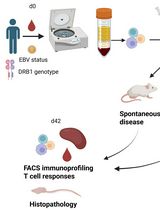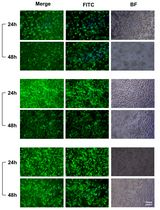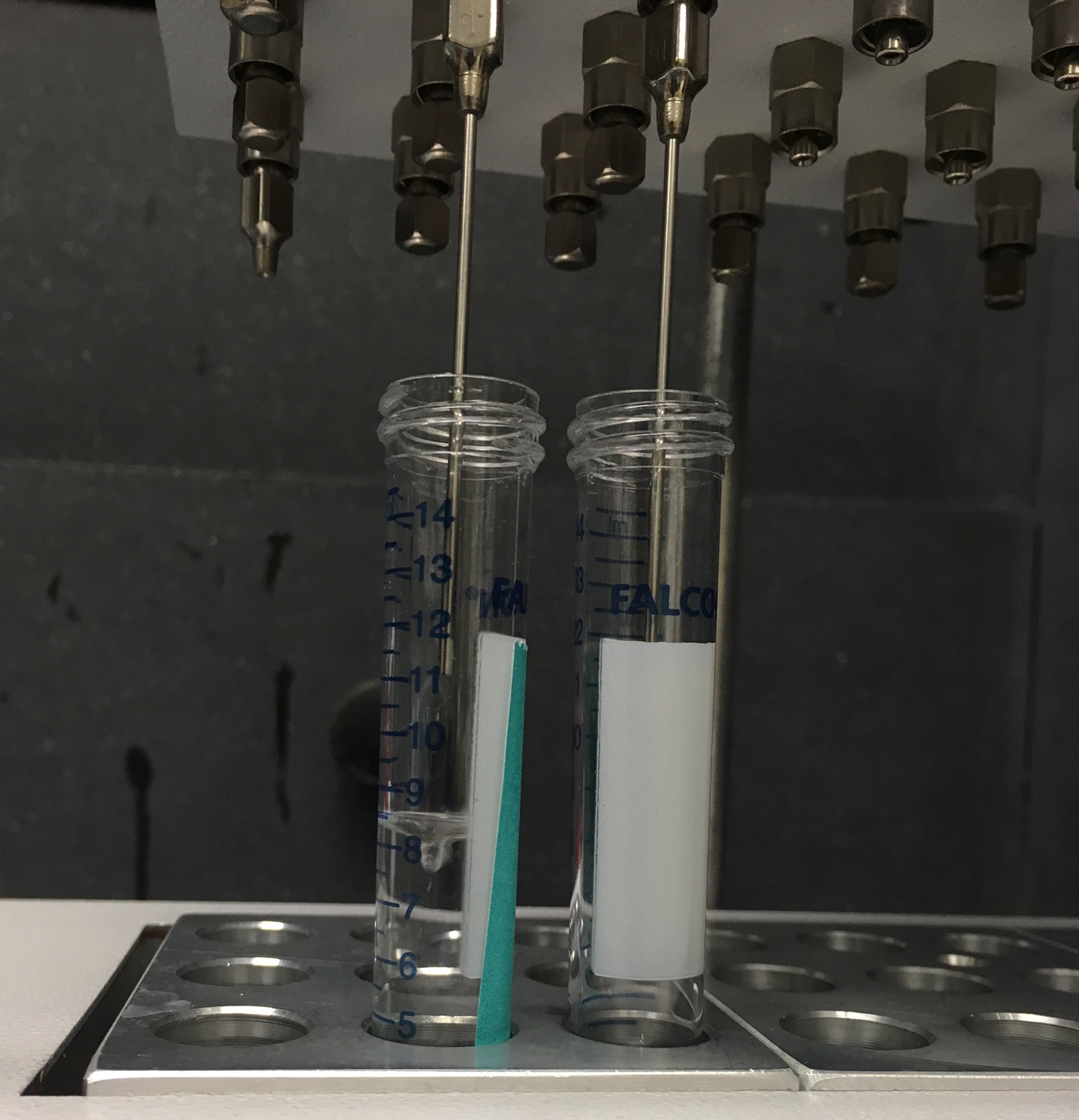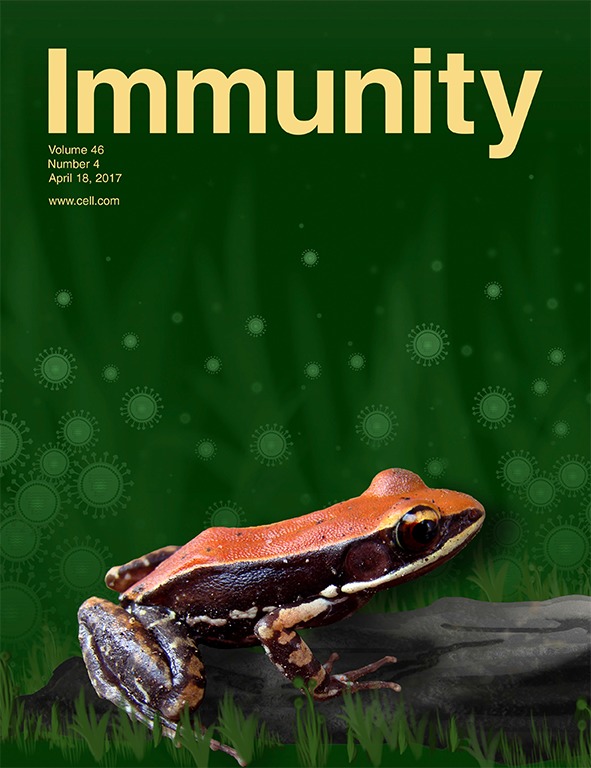- Submit a Protocol
- Receive Our Alerts
- EN
- EN - English
- CN - 中文
- Protocols
- Articles and Issues
- For Authors
- About
- Become a Reviewer
- EN - English
- CN - 中文
- Home
- Protocols
- Articles and Issues
- For Authors
- About
- Become a Reviewer
Eicosanoid Isolation from Mouse Intestinal Tissue for ELISA
Published: Vol 8, Iss 21, Nov 5, 2018 DOI: 10.21769/BioProtoc.3066 Views: 4715
Reviewed by: Ivan ZanoniXIAOMING SunChangyi Zhang

Protocol Collections
Comprehensive collections of detailed, peer-reviewed protocols focusing on specific topics
Related protocols

Analysis of Vascular Permeability by a Modified Miles Assay
Hilda Vargas-Robles [...] Michael Schnoor
Apr 5, 2025 1258 Views

PBMC-Humanized Mouse Model for Multiple Sclerosis: Studying Immune Changes and CNS Involvement
Anastasia Dagkonaki [...] Lesley Probert
May 20, 2025 2171 Views

Cost-Effective and Reproducible Preparation of mRNA-Loaded Lipid Nanoparticles Using a Conventional Laboratory-Scale Microfluidic Assembly System
Yunqi Li [...] Ruoyang Zhao
Sep 20, 2025 90 Views
Abstract
Activation of inflammasomes in peritoneal macrophages and intestinal epithelial cells (IEC) leads to the release of eicosanoids. To assess the amount of eicosanoids released by IEC, lipids need to be isolated from whole tissue previous to analysis by lipid mass spectrometry or ELISA. This protocol describes how to isolate lipids from intestinal tissue for analysis by PGE2-ELISA and normalize to tissue protein content.
Keywords: IntestineBackground
Inflammasome induced eicosanoid release is a relatively recent observation. It is not clear which cell/tissue types other than peritoneal macrophages and intestinal epithelial cells (IEC) (Rauch et al., 2017) can release prostaglandins upon inflammasome activation yet. This protocol can be adapted for other types of tissue as well as measurement of eicosanoid release induced by other stimuli than inflammasome activation in intestinal tissue.
Note that this protocol is specifically for use of eicosanoid analysis by ELISA, other protocols have been described for eicosanoid analysis by lipid mass spectrometry.
Materials and Reagents
- Culture tubes (Corning, Falcon, catalog number: 352059)
- 15 ml tubes (Corning, Falcon, catalog number: 352097)
- Flat bottom 96-well plates, transparent (Corning, Costar, catalog number: 3370)
- pH test strips (GE Healthcare, Whatman, catalog number: 2613-991)
- SPE Cartridges (C-18) (Cayman Chemical, catalog number: 400020)
- Paper towel
- Liquid nitrogen
- UltraPureTM water (Thermo Fisher Scientific, InvitrogenTM, catalog number: 10977)
- Indomethacin (Sigma-Aldrich, catalog number: I8280-5G)
- PBS (Thermo Fisher Scientific, GibcoTM, catalog number: 10010)
- 200 proof Kopec Ethanol (Decon Labs, catalog number: V1001)
- Methanol (Fisher Scientific, catalog number: A452SK)
- Ethyl acetate (Sigma-Aldrich, catalog number: 270989)
- Prostaglandin E2 ELISA Kit (Monoclonal) (Cayman Chemical, catalog number: 514010)
- BCA assay kit (Thermo Fisher Scientific, PierceTM, catalog number: 23227)
- K2HPO4 (Fisher Scientific, catalog number: P288)
- KH2PO4 (Fisher Scientific, catalog number: P285)
- DMSO (Sigma-Aldrich, catalog number: D8418)
- EDTA (Life Technologies, catalog number: 15575020)
- Sodium acetate (Sigma-Aldrich, catalog number: S2889)
- Acetic acid (Sigma-Aldrich, catalog number: A6283)
- Phosphate buffer (see Recipes)
- 1 M acetate buffer (see Recipes)
Equipment
- Forceps
- Scissors
- POLYTRON® PT 2500 E Stand Dispersion Unit (Ecoline) with 12 mm aggregate (Kinematica) or similar
- Fridge
- Centrifuge for 15 ml reaction tubes capable of cooling (Eppendorf 5810R or similar)
- Vortex
- 96-well plate reader capable of measuring absorbance between 405 and 420 nm and 562 nm (e.g., Molecular Devices, model: Spectramax® M2)
- Reacti-VapTM Evaporator (Thermo Fisher Scientific, catalog numbers: TS-18825 or TS-18826) or similar
- Nitrogen gas with pressure gauge hooked up to evaporator
- SPE Vacuum Manifold (Sigma-Aldrich, catalog number: 57250-U or similar)
- Vacuum trap (e.g., Fisher Scientific, FisherbrandTM Reusable Heavy-Wall Filter Flasks, catalog number: FB3001000) connected to central vacuum system or pump (e.g., Merck, Chemical Duty Vacuum Pressure Pump, catalog number: WP6122050) via tubing and rubber stopper
Procedure
Workflow:
| Day 1: | Animal treatment and tissue harvest (1-4 h depending on number of animals) |
| Day 1 or 2: | Tissue homogenization and centrifugation (30-60 min) |
| Evaporation 1 (60-90 min) | |
| Resuspend, pH, C-18 columns (30-60 min) | |
| Evaporation 2 (60-90 min) | |
| Resuspend, load ELISA (1-2 h) | |
| Day 2 or 3: | Finish ELISA (2 h) |
| Perform BCA assay (1 h) |
- Harvest intestinal tissue and immediately snap freeze in liquid nitrogen. To harvest intestine, cut open the peritoneum of sacrificed mouse, find stomach below lower end of the ribcage, separate small intestine from stomach and gently pull with forceps while separating from mesentery using scissors. Separate from anus and lay out to get an overview of the tissue. Make sure to harvest comparable areas of tissue from individual animals.
Note: 2 cm of tissue is easily sufficient. Mice do not need starving previous to tissue isolation. It is sufficient to remove large amounts of intestinal content by moving forceps along the chosen piece of intestine on a paper towel and thus squeeze most of the content out. - Homogenize tissue in 1 ml phosphate buffer/100 mg. Make sure tissue does not thaw before the homogenization step but drop frozen tissue directly into your homogenization-tube filled with buffer.
Note: Only turn homogenizer on once the tip is immersed in fluid with tissue. Move sample slightly up and down while homogenizing without removing tip from fluid completely. Homogenize at appropriate speed and for appropriate time to completely homogenize tissue (e.g., speed 26-30 for 10 s on POLYTRON® PT 2500 E). - Remove 30 µl aliquot of homogenate for BCA assay to determine protein concentration later, freeze (dilute 1:10 in PBS for assay: add 270 µl PBS to the 30 µl homogenate and mix).
- Pre-cool the centrifuge to 4 °C. To precipitate proteins, add 100% ethanol (four times the sample volume, e.g., with 1 ml homogenization buffer use 4 ml ethanol) to each tube. Vortex to mix thoroughly and put at 4 °C immediately. Incubate samples at 4 °C for 5 min, then centrifuge at 4 °C, 3,000 x g for 10 min to remove precipitated proteins. Transfer the supernatant to a clean test tube.
Note: If you homogenized a large amount of tissue in a lot of buffer, only use a 1.5 ml aliquot for these next steps, otherwise the evaporation will take a very long time. Remember to include this in your back-calculations at the end. Keep the rest of the supernatant at -20 °C until you are finished with the isolation, can be used as a backup in case something goes wrong. - Evaporate the ethanol under nitrogen to complete dryness (takes 60-90 min for 1.5 ml)
- Use ~2 PSI pressure per 16 samples (increase or decrease pressure if more or less samples are dried), increase accordingly. Keep moving needles down onto samples to a distance so bubbling can be heard but no splashing is observed. See also Figure 1.

Figure 1. Needle positioning during nitrogen drying. Surface rippling of the liquid should be observed, but no drops should be splashing to the sides of the tubes. - Yellowish remnants in the tube are normal.
- Use ~2 PSI pressure per 16 samples (increase or decrease pressure if more or less samples are dried), increase accordingly. Keep moving needles down onto samples to a distance so bubbling can be heard but no splashing is observed. See also Figure 1.
- Resuspend sample in UltraPureTM water and acidify to ~pH 4.0 by the addition of 1 M acetate buffer.
Note: For your first sample, carefully add more acetate buffer as you go and note how much you need, then add the same amount to samples of the same type. For sample evaporated from 1.5 ml, resuspended in 300 µl, amount of acetate buffer needed is approximately 45 µl. Sample can also be resuspended in more water if desired, this will however increase column time in Step 9. For the first test of a certain sample type it is recommended to have more sample for pH testing. To check the pH of your sample using very small amounts, cut a pH test strip lengthwise to about 1/4 of the original width and use 5 µl distributed in drops onto the test fields. Record the amount of sample removed to include in back-calculations. If the samples contain precipitate, centrifuge to remove the precipitate. Particulate matter in the sample may clog the SPE Cartridge (C-18). - Put as many C-18 cartridges as samples onto vacuum manifold, close unused outlets.
- Set vacuum on vacuum manifold to ~4. Prepare SPE (C-18) columns by rinsing with 5 ml methanol followed by 5 ml deionized water. (Drop speed should be ~2/sec). Do not allow the SPE Cartridge (C-18) to run dry until Step 10. The little valves below the cartridge can be used to adjust drop speed/stop cartridge if sample is in danger of running dry.
- Apply the sample to the SPE Cartridge (C-18) and allow the sample to completely enter the packing material.
- Wash the column with 5 ml deionized water. Discard the wash. Let column run dry (increase vacuum to get completely dry).
- Elute the PGE2 from the column with 5 ml ethyl acetate containing 1% methanol. Make sure valves are from a material not sensitive to this solvent (or, if another type of vacuum manifold using stopcocks is used, remove them and let ethyl acetate enter column by gravity, elute with low vacuum.).
- Evaporate the ethyl acetate to dryness under a stream of nitrogen as described in Step 5. It is very important that all of the organic solvent be removed as even small quantities will adversely affect the ELISA (takes again about 60-90 min).
- To resuspend the sample, add 500 μl ELISA Buffer from the ELISA kit, no matter the initial volume. This amount ensures enough buffer in the kit is left for sample dilutions and preparation of other reagents. If more starting material was used, consider this in the sample dilution in Step 14. Vortex. It is common for insoluble precipitate to remain in the sample after addition of ELISA Buffer; this will not affect the assay. This sample is now ready for use in the ELISA.
- Depending on expected PGE2 concentrations sample needs to be diluted in ELISA buffer. After systemic inflammasome activation, dilution of 1:100 is recommended.
- Perform PGE2 ELISA as described in Chayman chemicals protocol (https://www.caymanchem.com/pdfs/514010.pdf).
- Perform BCA assay on aliquots of tissue homogenate taken after homogenization of tissue according to kit protocol. Dilute tissue homogenate 1:10 in PBS for assay.
Note: Make sure to also dilute standards in phosphate homogenization buffer/PBS 1/10.
Data analysis
Back-calculate sample PGE2 concentration according to the description in the ELISA protocol. Do not forget to account for taking only an aliquot of the spin supernatant.
Calculate the amount of protein in sample according to BCA assay.
Now you can calculate the ratio of PGE2/mg total protein in your sample.
Notes
- Load the samples onto the ELISA on the day of extraction, eicosanoids are very unstable, even at -80 °C.
- Depending on your tissue and eicosanoid production induction, you might have to test for different amounts of tissue used for isolation or different dilutions of sample used in the ELISA.
Recipes
- Phosphate buffer
- Stock: 133 g K2HPO4 + 32.15 g KH2PO4 in 1 L UltraPureTM water. The pH should be 7.4.
- Dilute 1:10, add 1 mM EDTA + 10 µM Indomethacin right before use. Indomethacin needs to be dissolved fresh at 10 µM in DMSO
- 1 M acetate buffer
- Add 0.93 g sodium acetate and 2.32 g acetic acid to 40 ml UltraPureTM water, mix
- Fill up to 50 ml with UltraPureTM water
Acknowledgments
This protocol was developed with the help of the Gronert laboratory at UC Berkeley.
Funding: HHMI and NIH grants (AI075039, AI063302, EY026082), Austrian Science Fund (FWF) (the Erwin Schroedinger Fellowship J3789-B22).
Competing interests
The author declares no conflict of interest.
Ethics
The animal experiments complied with the regulatory standards of, and were approved by, the University of California Berkeley Institutional Animal Care and Use Committee.
References
- Rauch, I., Deets, K. A., Ji, D. X., von Moltke, J., Tenthorey, J. L., Lee, A. Y., Philip, N. H., Ayres, J. S., Brodsky, I. E., Gronert, K. and Vance, R. E. (2017). NAIP-NLRC4 inflammasomes coordinate intestinal epithelial cell expulsion with eicosanoid and IL-18 release via activation of Caspase-1 and -8. Immunity 46(4): 649-659.
Article Information
Copyright
© 2018 The Authors; exclusive licensee Bio-protocol LLC.
How to cite
Rauch, I. (2018). Eicosanoid Isolation from Mouse Intestinal Tissue for ELISA. Bio-protocol 8(21): e3066. DOI: 10.21769/BioProtoc.3066.
Category
Immunology > Animal model > Mouse
Immunology > Mucosal immunology > Digestive tract
Biochemistry > Lipid > Lipid isolation
Do you have any questions about this protocol?
Post your question to gather feedback from the community. We will also invite the authors of this article to respond.
Tips for asking effective questions
+ Description
Write a detailed description. Include all information that will help others answer your question including experimental processes, conditions, and relevant images.
Share
Bluesky
X
Copy link









